
Waldviertelbahn (Gmünd narrow gauge railways)
Gmünd is the starting place of the railway lines system with the gauge 760 mm. There are starting two lines,
one of them leads to north and the other to south. Northern line devides in Alt Nagelberg, one branch goes to
Litschau, another branch to Heidenreichstein. Southern line ends in Gross Gerungs. According to the original plan
the northern part should have joined narrow-gauge raiway lines in Nová
Bystřice from Litschau. Mentioned connection wasn't never realized.
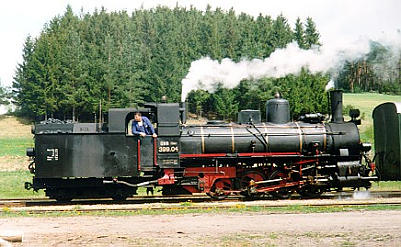 |
| 399.04 s Os vlakem Gross Gerungs - Gmünd v Steinbachu (photo Daniel Brabenec 3. 5. 1998) |
General length of this railway system was 82,703 km after construction, line to Gross Gerungs reached for 44 km,
northern line measured 38 km, it`s branch from Alt Nagelberg to Heidenreichstein measured 13 km. Maximum rise is
20 per mille on northern line, southern line reaches as far as 25 per mille. On the railway line to Gross Gerungs
are two tunnels (about length 80 m and 250 m) and several viaducts (the best-known is 15 m high and you can find it
near Weitra). The railway lines were built with minimum curve radius 100 m and for maximum speed 30 km/h.
Discussion about local railway lines construction round Gmuend began in the end of 19th century already, on 12th
November 1898 and on 9th October 1901 there were given licence for construction and railway service. There was
supposed only scanty goods-traffic so the line is built like narrow-gauge railway. The construction began soon
after November 1898 and on 4th July 1900 the northern branch into Litschau with turning into Heidenreichstein were
given to public services, the station in Litschau was projected for later possible connection with Nová Bystřice.
The built of southern branch finished step by step, first section from Gmuend to Steinbach-Gross Pertholz was
passed on 10th October 1902, the rest of line to Gross Gerungs was given to public services on 1st March 1903.
According to the original plan the line should have gone on over Rappotenstein and Ottenschlag to Krems a.d. Donnau.
This intention was however interrupted during the World War I and wasn't realized.
The operator of both tracks was NOeLB (Niederostereicher Landesbahnen), which here operated passenger also goods
traffic. Goods there were transported in narrow gauge wagons. Normal gauge wagons were transported on trailers,
later on trailer wagons. After nationalization in 24th September 1922 traffic was assumed by state railways BBOe.
From 18th March 1938 the railway line was passed below control of DR (Deutsche Reichsbahn - German Imperial
Railways) for the whole World War II. The end of the war meant return back bellow control of state railway, now
called OeBB (Oesterreichische Bundesbahnen), in this proprietorship the rail is to nowadays together with others
Austrian narrow gauge railway lines 760 mm - Mariazellerbahn,
Ybbstalbahn and Pinzgaubahn (Zell am See - Krimml).
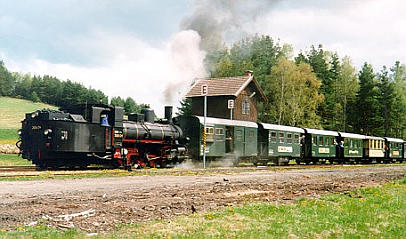 |
| 399.04 s Os vlakem Gross Gerungs - Gmünd v Steinbachu (foto Daniel Brabenec 3. 5. 1998) |
After World War I the territory was devided and the station Gmuend together with 3,784 km of lines accrualed to
Czechoslovak Republic. That is why there was built new station Gmuend-town on the place of the samenamed stop.
Trains began go out from this station on November 1922, but the track still led up all the time through Czechoslovak
territory around station in České Velenice, from where the trains returned to Austrian territory near the stop Gmünd
Behmzeil. On 15th March 1927 the state contract about traffic through Czechoslovak territory was signed. This way of
traffic functionned until 1950, when there was built line relaying leading only through Austrian territory.
The coming of the World War II and also the new separation of Czech state territory added from 1938 the rail
Jindřichův Hradec - Nová Bystřice with all vehicles of the place below control of locomotive shed in Gmuend. The
Nova Bystrice rail thereby accrualed to the Directorium of imperial rails in Vienna. Locos and rolling stock were
changing among locomotive sheds in this period too. Therefore after the end of the war some former Czech vehicles
stayed on territory of Austria. OeBB utilized locomotive shed and railway works in Ceske Velenice until July 1945.
After the World War II normal passenger also goods traffic started on the rail. Together with two-axles trailer
also four-axles trailer wagons get on into operation in freight transport, purveyanced from year 1943. In the
beginning of sixtieth enter into life of narrow-gauge railways also first diesel locos and these ones assumed step
by step traction from steam locomotive.
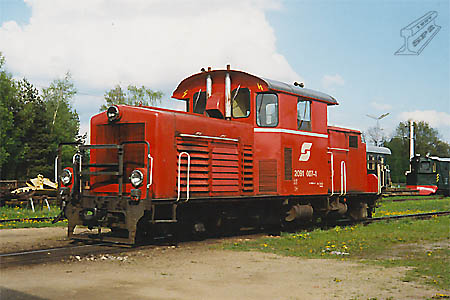 |
| 2091.007-1 odstavená v Gmündu (foto Daniel Brabenec 3. 5. 1998) |
Motor coachesof series 5090 substitute classical locos in spite of rationalization of operation and also in spite
of redusing of operating costs in passenger service in 1986. Together with these changes also passenger service on
line into Litschau is stopped in the end of May in 1986.
Negligible goods transport is then the reason of stopping freight traffic on turning Alt Nagelberg - Heidenreichstein
on July 1992. From this date passenger service is operating only on track into Gross Gerungs, where two motor coaches
regularly change. Goods traffic is practising by locos of serie 2095 on lines into Gross Gerungs and Litschau, but
it´s decreasing volume faces to thinking about early termination.
In Gmuend steam locos of the place stayed even after termination of steam operation. OeBB fortunately inform the
magnetism if it´s operation for tourists and that´s why the trains with steam locos are operated on track into
Gross Gerungs and sometimes into Litschau every weekend.
Around these local narrow-gauge railways arosed a club - Waldviertler
Schmalspurbahnverein - which began make incidental rides into Litschau and Heidenreichstein with rented
locomotive 399.03 in the end of eightieth.
After the stopping of traffic on route Alt Nagelberg - Heidenreichstein this club tries restore the service on this
route. From 1993 the club has in it´s hire the section Heidenreichstein - Aalfang, in 1996 obtained the section
Aalfang - Langegg and from 1. 1. 1997 club has rented whole turning from the km 0,246 (under station Alt Nagelberg)
til Heidenreichstein (km 13,154). On this turning is practising an incidental seasonal transport.
The majority of narrow-gauge vehicles in Austria alternated on traffic on this
railway. In the beginning there were steam locomotives of the serie U and Uv, later also the serie Mh, originally
delivered for Mariazellerbahn. During the war also first diesel locos and in the beginning of sixtieth also first
locomotives serie 2095 comed there. These locos at first shared on traffic together with steam locos then picked
all achievement. From 1986 they are here too into service two motor coaches of the serie 5090. Steam locomotives
are from ninetieth used only for leading homesick trains.
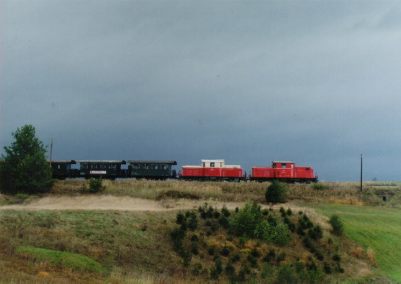 |
| 2091.07 + 2091.12 (foto Jiří Konečný 8. 10. 1999) |
Two motor coaches 5090.004, 005, five diesel locomotives 2095.011 - 015 and two 2091.002 and 007 were deposited
in Gmuend depot on 1st January 1999. There are steam locomotives 399.003, 004 and 298.207 too.
The passenger trasport on track into Gross Gerungs was till 8th June operated with two alternating motor rolling
stocks, only in case of disturbances they were replaced by the loco 2095 with classical coaches. Goods-traffic was
operated with the moorning train into Gross Gerungs and back but the train rided only to station to which it had
been loaded. There went also a midday train to northern branch if it was needed. This ride was operate with machine
2095. Steam locos goes on homesick weekend trains into Gross Gerungs and occasionally also into Litschau.
With the new railway flow sheet 2001/2002 ÖBB stopped little used personal traffic on the track to Gross Gerungs and
also on the whole narrow gauge railway net in Gmünd. Also sporadic goods traffic was terminated in the same date.
The railway net was abandoned from ÖBB and it dessapeared from the map of Austria railways.
So you can meet on local railways only weekend homesick trains with steam locomotive. It rides only through tourist
season from May till the end of the October.
Text Daniel Brabenec
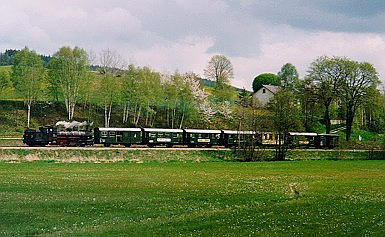 |
| 399.04 s Os vlakem Gross Gerungs - Gmünd za Steinbachem (foto Daniel Brabenec 3. 5. 1998) |
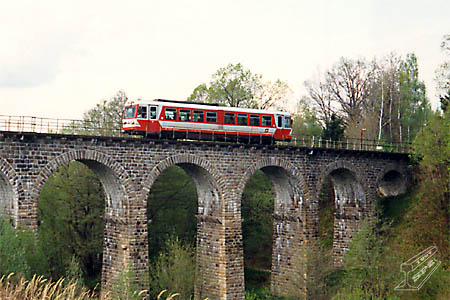 |
| 5090 na viaduktu za Weitrou (foto Daniel Brabenec 3. 5. 1998) |
| Literature |